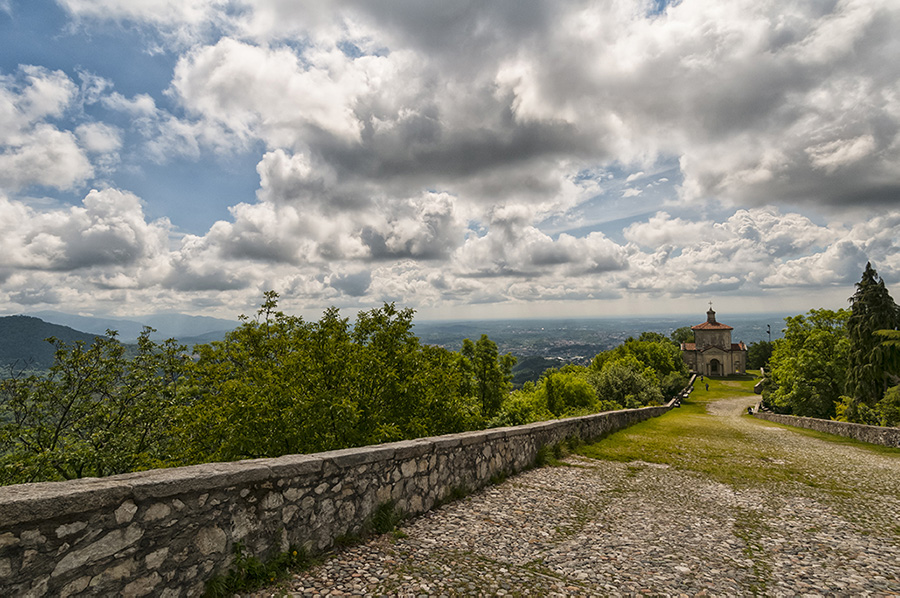
The Sacro Monte of Varese is a religious complex built on the mount of Velate between 1604 and 1698 and compoused by 14 Chapels. Its aim was to spread the Catholic faith to local people as a way of combating the growing influence of the protestant reformation.
A 2 km pilgrims’ trail with 14 chapels dedicated to the mysteries of the Rosary leads to the top of the Sacro Monte. Access to the chapels
path is gained by a paved road (via Conventino), which is also an alternative route to the pedestrian pilgrims’ trail.
The Pilgrims’ Trail, which was set up by Giambattista Aguggiari, a Capuchin friar, allowed pilgrims to follow a clearer path than the previous,
more challenging road. The chapels were designed by the eminent architect Giuseppe Bernascone from Varese according to different models which
make each chapel unique and blend harmoniously with the surrounding nature. Chapels are filled with dioramas made of polychrome terracotta by Francesco Silva,
who carved the sculptures of ten chapels, Dionigi Bussola, Cristoforo and Marco Antonio Prestinari, Martino Retti, Carlo Antonio Buono.
Frescoes, which provide a setting for dioramas by depicting large landscapes, interiors of churches, spectators to the event or narrative episodes,
were painted by artists such as Pier Francesco Mazzucchelli called Morazzone (VII chapel, 1609)
The Sacro Monte of Varese is part of Via Francisca del Lucomagno, an ancient route that connects Constance to Pavia which was travelled by emperors (including Frederick Barbarossa), merchants, bishops and pilgrims. At approximately 510 km long, 135 km of which are in Italy, it can be divided into 8 stages until Ponte Tresa to Pavia.
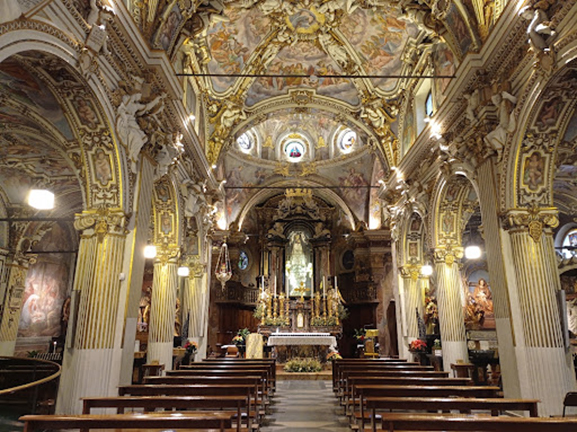
The present shrine is the result of various building phases, as confirmed by archaeological excavations undertaken during the restoration of the crypt, which ended in October 2015.
Three main buildings can be identified:
- A church belonging to the Carolingian-Ottonian period (9-10th century) with a semi-circular apse at its east end (the present Crypt);
- A new Romanesque church, which was extended to the west and raised high on a pre-existing church so that the chancel could be turned into a crypt, with a staircase leading down into it.
- The considerable restoration works of 1472-1476 by architects Bartolomeo da Cremona called “Il Gadio” and Benedetto Ferrini da Firenze who, by the will of the duke of Milan Galeazzo Maria Sforza and his ancestors, enlarged the Romanesque church by adding two more aisles and rebuilding the three-apsed chancel.
The rich decorative program commissioned by the signori of Milan for the most important Marian shrine of their duchy is almost lost and the Shrine of Santa Maria del Monte sopra Varese is currently adorned with 17th-century magnificent frescoes by Giovan Mauro della Rovere, Giovanni Paolo Ghianda, Salvatore Bianchi and the Lampugnani, which are framed by rich Baroque stucco decorations. The impressive high altar, where the 4th-century worshipped wooden statue of the Virgin with the Child stands, was made in the second half of the 17th century. Works to beautify the interior of the church in the 17th century are related to the great challenge of the Pilgrims’ Trail, with its fourteen chapels dedicated to the mysteries of the Rosary.
In the shrine on the top of the arch of the central nave, there are some windows connecting the church with the Convent of Romite Ambrosiane. From the windows the nuns can follow the holy mass in the shrine without leaving the convent.
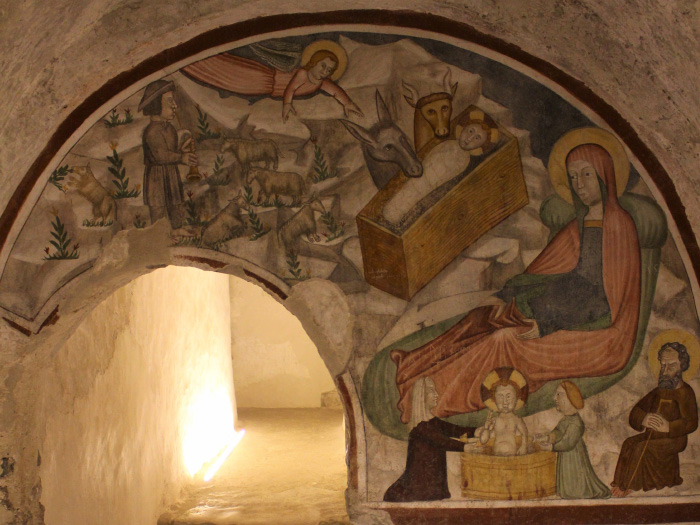
The Crypt is the first church built on the top of the mountain during the IX-X century. Open to the public in 2015 after important restoration works, the Crypt is the heart of the history of Santa Maria del Monte. Built as a church, the building was turn in an underground holy place during the XII century, when the new church was built.
The frescoes of the crypt show a consistent style which can be attributed to the same artists, who painted them at different times within few years. Experts disagree on the dating of the frescoes: some of them think they were made between 1360 and 1370 whereas others believe they date back to the 15th century, as their painting style is similar to the 1408 frescoes of the Schirannetta in Casbeno. They are, undoubtedly, works by a local workshop, which succeeded in depicting figures marked by a rigid frontality but easily recognizable, whose worship features are emphasized more than the artistic ones.
In 2013 the excavations in the small three-aisled vaulted Sacro Monte di Varese crypt unearthed some important remains of walls and floors which clearly prove that a far older building dedicated to the cult of the Virgin – which is still unknown - pre-existed there (probably of the V-VI century).
During the restoration work important remains and frescoe were discovered also in the two corridors of the Crypt: in the forst one it is pobbile to admire an interesting pianting decoration of the XV century; in the secondo ne important archaeological remais were unearthed of an burial oratory of the VIII centuri.
On the frescos of the Crytp, many graffiti are present. It is possible reading names and dates carved out into the walls by the pilgrims of the XVI-XVII century.
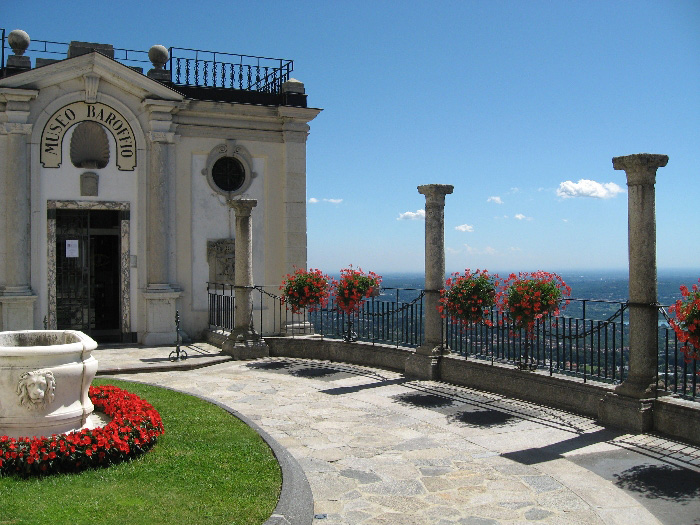
The Museo Baroffio e del Santuario welcomes visitors who wish to know the history of Santa Maria del Monte through enjoying the beauty of Romanesque sculptures, miniatures of valuable codices and antependia of the Sforza period; it is also aimed at those who are interested in the heritage of all the works that have been acquired so far, first and foremost the 15-18thcentury paintings given by the baron Giuseppe Baroffio (Brescia 1859 – Azzate 1929) and then the section about contemporary sacred art.
The Museum was built thank to the donation of the Baron Giuseppe Baroffio Dall’Aglio. The project was planned by the artist Lodovico Pogliaghi and the Museum was open to the public in 1936. During the years the museum and its collection changed several times and in the XX century Mons. Pasquale Macchi created the contemporary section of the museum where it is possible to admire artworks of Bodini, Longaretti, Manfrini, Guttuso, Matisse e Rouault.
The symbol of the museum is the stone statue of Mother Mary with the Child, made by the artists Domenico e Lanfranco da Ligurno in 1196. It is an example of the stone decoration of the Romanesque shrine. In the museum, in addition, you can find artworks that testify the long history of Sacro Monte of Varese.
The most curious element preserved inside the museum is a crocodrile, the so called “dragon of Breno”. According to the legend the animal was murdered by a young boy of Breno, a small village in Switzerland, and gave to the shrine as an ex-voto.
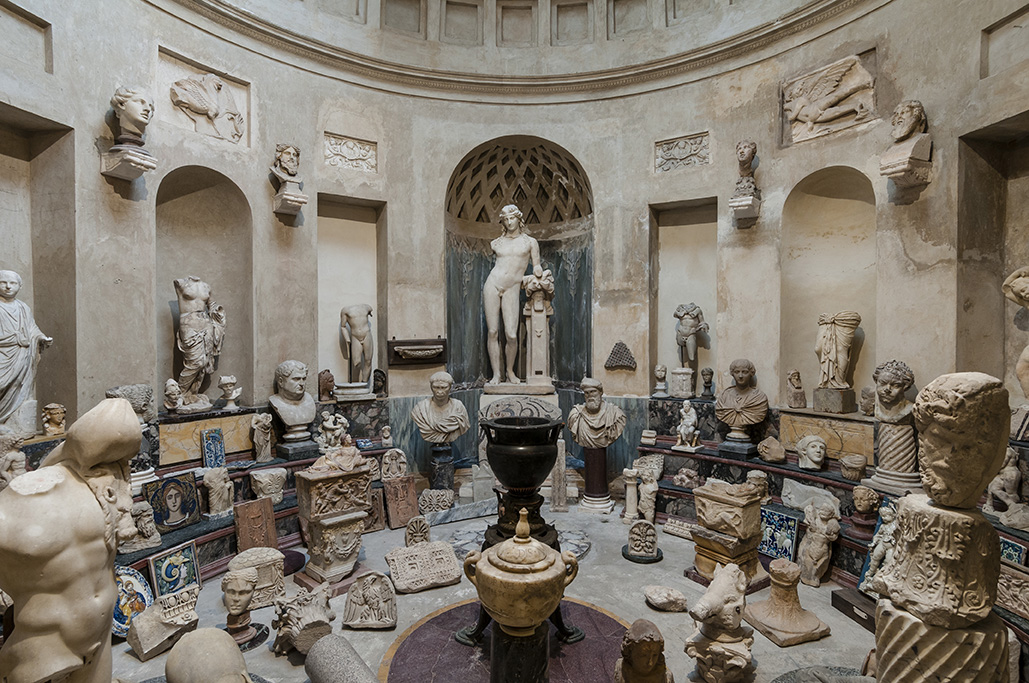
Whilst working on the restoration of the chapels of the Sacro Monte in Varese, the artist and collector Lodovico Pogliaghi (Milan 1857 – Varese 1950) was intrigued by these beautiful and quiet spots. Pogliaghi purchased some adjacent plots for his house in 1885 and began making plans for its construction. He industriously worked at it until he died in 1950.
The house was intended to be used as a laboratory-museum, where he could have relaxed, studied and exhibited his collections. The building, which was planned by Pogliaghi himself, provides an insight into the eclectic taste of that period and the owner’s interest in all arts. Its rooms enjoy a mixture of architectural styles and the Italian-style garden is rich in antiquities and curiosities.
Lodovico Pogliaghi’s collection includes valuable Egyptian, Etruscan and Greco-Roman archaeological finds, paintings and sculptures dating back to the years between the Renaissance and the Baroque, a rich collection of old European and Asiatic textiles, exquisite historic furniture, curiosities and odd objects from all over the world. In addition to his collection the villa features sketches, plaster casts, drawings and work materials of Pogliaghi. Besides being an artist, a sculptor, an architect and a scenographer, he was also very dedicated to graphics, glyptics, jewellery and glassware. He gained some important commissions and his most famous artwork is definitely the main door of the Duomo of Milan, whose original plaster is hosted in the House Museum. On the whole, the House Museum houses over 1500 artworks including paintings, sculptures and applied arts and approximately 580 archaeological objects.
The villa, which was donated by Pogliaghi to the Holy See in 1937 and it is now owned by the Veneranda Biblioteca Ambrosiana of Milan.
One of the most interesting and curious part of the Pogliaghi’s collection are the ancient Egyptian remains. In the Golden Gallery there are two coffins: the best preserved is the sarcophagus of a woman called Tameramun – the singer of the temple of Amon in Karnak – and it is dated back to XXV dinasty.
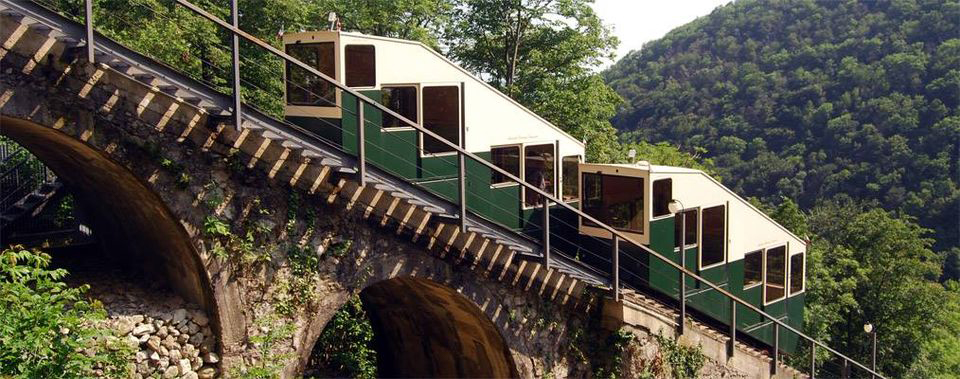
The historic Varese Sacro Monte funicular, designed by engineer Vittorio Brezzi, was inaugurated in 1909 as part of an advanced transport system connecting Varese to its main tourist destinations. The electric traction system overcame a height difference of 168 metres for Sacro Monte and almost 600 metres for Campo dei Fiori. At the time, in fact, there were two lines operating from the Vellone valley station: one ran to the Grand Hotel Campo dei Fiori, on the summit of the mountain of the same name, and the other connected the valley with the village of Santa Maria del Monte.
The Sacro Monte funicular was financed by the Società Varesina Imprese Elettriche and the Società dei Grandi Alberghi: in fact, it mainly served tourists and guests of holiday resorts. The Art Nouveau stations are an important trace of the early 20th century, while the elegant ramped arches harmonise with the landscape, enhancing the funicular's inclusion in its natural surroundings. The function of the means of transport was discontinued in 1953, until the reactivation in 2000 of the line to the village of Santa Maria del Monte by the Municipality of Varese, which restored to visitors the charm of a journey from another era and a convenient alternative to the car.
Today, as in the past, it is possible to board at the Vellone station, which can be reached by bus or on foot from Piazzale Montanari. The ride lasts approximately 2 minutes and the service is provided by two cars with 55 seats each, on which it is possible to transport 2 persons (1 person per car) with reduced mobility.
In an hour and a half from Milan: in the 20th century it was possible to reach Campo dei Fiori from the metropolitan city by a route entirely by rail. One took the electric train at Cadorna, passing through Saronno and Malnate, and then getting off at Varese. After a short walk, the tram would take you from Piazza Monte Grappa (then Piazza Porcari) to the funicular station and then from there to the top of Campo dei Fiori. All in 90 minutes from Milan.
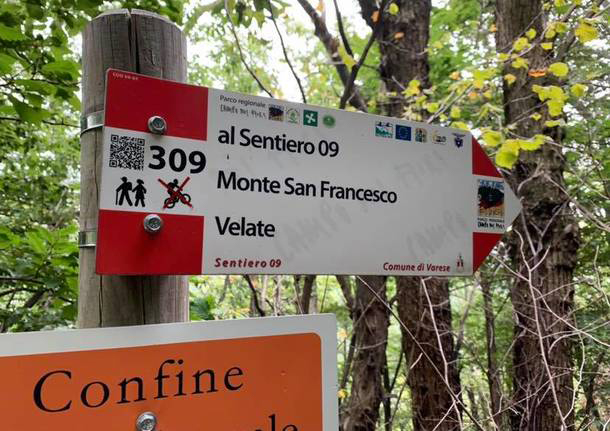
Path 9/309 of the Campo dei Fiori Park connects the village of Velate with Santa Maria del Monte. Before the Viale delle Cappelle was built in 1604, this path was one of the main access routes to the sanctuary for pilgrims. Today, it is an alternative in nature to the main road or driveway, offering a silent walking experience through a remarkable wooded landscape.
The route begins in the upper part of Velate, a hamlet of Varese, an ancient medieval town known for its tower and the parish church of San Stefano. After passing Piazza Rizzi and taking Via Adda, you come to a fork in the road: continuing to the right, you climb up the course of the Vellone in the direction of the Marmitte dei Giganti, while to the left, path no. 9 climbs the slope. The vegetation consists mainly of chestnut, fir and beech trees; we walk past a structure of the Varese Aqueduct before tackling the ascent along the slope of Monte San Francesco.
A variant of path no. 9 leads to the summit of Monte San Francesco (793 m), where the ruins of the Monastery of San Francesco in Pertica, active from the 13th to the 16th century, are located. The foundations of a tower and a church, once part of a sighting and defence system, are still visible in this area. The place name “in Pertica” recalls burials from the Longobard era, in which poles were erected with wooden doves facing the place of the warrior's death.
Whether one takes the high path towards San Francesco or the mid-slope one, both paths then lead to the access road to the village of Santa Maria del Monte. Shortly before arriving at the village, you come to the Fonte del Ceppo, a karstic spring located in a shady hollow, once renowned for the alleged therapeutic properties of its waters, today not drinkable. Past the spring, the road then leads to the Sanctuary of Santa Maria del Monte, via Beata Caterina and via Salvatore Bianchi. The total height difference is about 250 metres; the average walking time is 1 hour and 30 minutes.
Renato Guttuso, the internationally renowned Sicilian painter, also chose the Varese Pre-Alps as his creative refuge. In Velate, in the Villa Dotti inherited from his wife Mimise, he spent his summers immersed in the quiet of the village overlooking the southern slope of Campo dei Fiori.It is right here that La Vucciria was born, one of his most famous works. Although it depicts the popular market in Palermo, it was made entirely in the Varese studio. Fish and langoustines were flown in from Palermo; the famous quarter beef was instead supplied by a local butcher.
His figure also impressed Monsignor Pasquale Macchi, archpriest of Sacro Monte and former secretary to Paul VI, who entrusted him with the work on the Third Chapel, where time had compromised Nuvolone's Flight into Egypt. Guttuso accepted: in 1984 he created a new version of the scene, opting for an acrylic mural on a cement panel instead of a fresco.
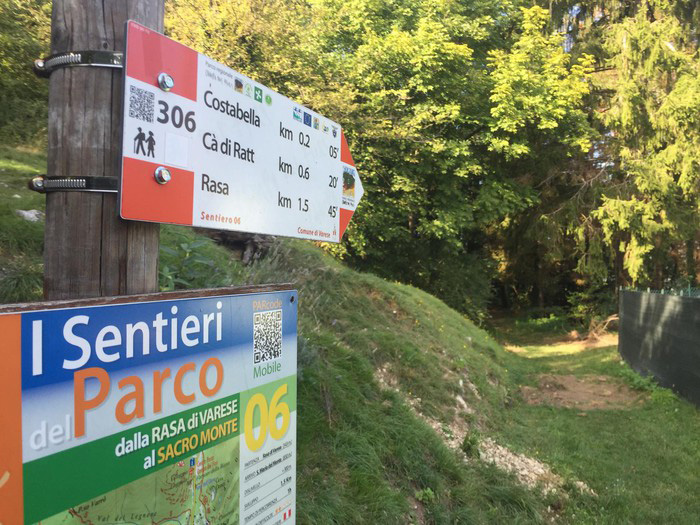
The route from Rasa, a hamlet in the municipality of Varese, is a secluded and wild path that winds through the woods of the Campo dei Fiori Park. Historically used by wayfarers coming from Valcuvia and Verbano to reach the Sanctuary of Santa Maria del Monte, before the Viale delle Cappelle was built, today it is a popular choice for hikers looking for a suggestive and less frequented route. The trail is 1.5 km long and has an altitude difference from 543 m to 830 m, which can be covered in about 1 hour and 45 minutes.
The starting point is located near the village of Rasa, opposite the village cemetery, at the junction of Via delle Sorgenti and the Provincial Road, not far from a car park. Follow Via delle Sorgenti until you reach the picturesque hamlet of Molino, where the characteristic tavern “Crotto del Mulino” (also known as “dul Pep”) was located, a traditional meeting place in the coolness during the summer months. From here, the route continues along a mule track and a steep path, which leaves the upper part of Val Sesnivi on the right, rich in natural springs, including those that supply water to the city of Varese. The climb is steep and passes through birch woods and limestone rocky areas, until it meets a path coming from the Fifth Chapel of Sacro Monte.
After the more challenging section, we proceed through small valleys and coppice woods, with a more moderate gradient, until we reach Piazzale Pogliaghi, from where there is a panoramic view of the Rasa valley, Monte Martica and the Lombardy Pre-Alps. This access point is also easily accessible by public transport.
Before taking the path to Santa Maria del Monte, it is possible to visit the springs of the Olona River at La Rasa. Located in the park of Villa Cagnola, at Fornaci della Riana, they are a point of great historical and environmental interest. This area, which is home to a monumental dwelling dating back to the early 20th century, has recently undergone a renaturalisation project that has enhanced and preserved the springs, restoring their importance in the local historical context.
Project of Comune di Varese: “Da Globale a locale: riscoperta e valorizzazione dell'identità di luoghi eccezionali", sostenuto dal Ministero del Turismo e volto alla valorizzazione dei Comuni nel territorio del Sito UNESCO "Sacri Monti del Piemonte e della Lombardia".

